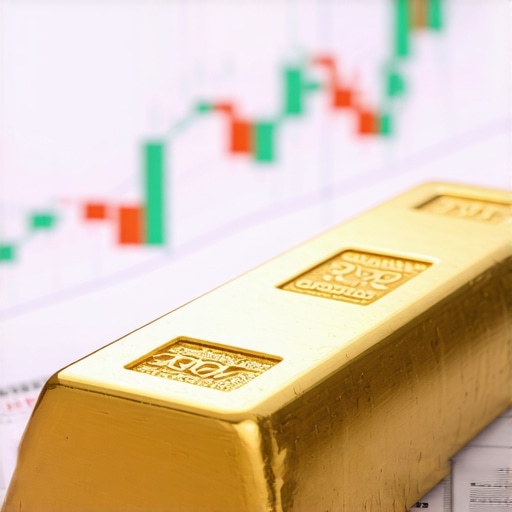Understanding Gold Futures: A Smart Investment Choice
Gold has long been considered a safe haven for investors, especially in times of economic uncertainty. As a tangible asset, it provides security that other investments cannot match. With the rise of gold futures trading, savvy investors have a unique opportunity to maximize their gains. By leveraging gold futures, you can take advantage of price fluctuations without the need to physically own the gold itself.
Gold futures are contracts that obligate the buyer to purchase gold at a predetermined price at a specified future date. This allows investors to speculate on the future price movements of gold, making it an attractive option for those looking to profit from market volatility. However, navigating the world of gold futures requires a solid understanding of the market and effective strategies for success.
Key Strategies for Maximizing Gains in Gold Futures
To successfully invest in gold futures, you need to implement specific strategies that align with your financial goals. Here are some proven techniques to help you maximize your gains:
1. Conduct Thorough Market Analysis
Before entering the gold futures market, it’s essential to conduct a thorough analysis of market trends and economic indicators. Factors such as inflation rates, currency fluctuations, and geopolitical events can significantly impact gold prices. Understanding these trends will help you make informed decisions and time your trades effectively. For instance, analyzing how global events impact gold prices can provide you with valuable insights into potential price movements.
2. Utilize Risk Management Techniques
Investing in gold futures carries inherent risks, and it’s crucial to manage these risks effectively. Consider implementing stop-loss orders to protect your investments from significant losses. Additionally, diversifying your portfolio by combining gold futures with other assets can help mitigate risk. For more information on balancing your investment strategies, check out our post on diversifying your portfolio with gold.
3. Stay Informed About Market News
Keeping abreast of market news and trends is vital for gold futures traders. Subscription to financial news outlets and following expert analyses can help you stay updated on price movements and economic forecasts. Engaging with resources that provide insights into the future of gold prices can also enhance your trading strategy.
4. Leverage Technical Analysis Tools
Many successful gold futures traders rely on technical analysis tools to identify entry and exit points. Chart patterns, moving averages, and indicators like the Relative Strength Index (RSI) can provide valuable signals for trading decisions. By integrating these tools into your strategy, you can enhance your trading prowess and increase your chances of profitability.
5. Develop a Clear Trading Plan
A well-defined trading plan is essential for success in gold futures trading. Your plan should outline your investment objectives, risk tolerance, and specific strategies you intend to use. Regularly reviewing and adjusting your plan based on market conditions will ensure that you remain flexible and responsive to changes in the gold market.
In conclusion, maximizing your gains in gold futures trading requires a combination of market knowledge, strategic planning, and risk management. By implementing these strategies and staying informed about market trends, you can navigate the complexities of the gold futures market with confidence. For more in-depth information on the gold investment landscape, consider exploring our comprehensive guides on gold investment approaches and analyzing gold market trends.
Understanding the Importance of Market Timing in Gold Futures
One of the critical factors that can determine your success in gold futures trading is market timing. This means knowing when to enter or exit a trade based on market conditions, price movements, and economic indicators. Analyzing gold market trends can provide valuable insights into potential price fluctuations, helping you make informed decisions that enhance profitability.
1. Utilize Economic Indicators
Economic indicators such as GDP growth, inflation rates, and employment figures can significantly influence gold prices. Monitoring these indicators will help you gauge market sentiment and identify optimal trading opportunities. For instance, a rise in inflation typically leads to increased demand for gold as a hedge against currency devaluation. To learn more about how these factors affect the market, check out the impact of inflation on gold prices.
2. Keep an Eye on Central Bank Policies
Central banks play a crucial role in shaping gold prices through their monetary policies. Interest rate changes and gold reserves can lead to significant market shifts. Understanding how central bank purchases influence gold prices can provide you with a strategic advantage. By staying updated with central bank announcements, you can better anticipate market movements.
Advanced Trading Techniques for Gold Futures
In addition to market timing, employing advanced trading techniques can significantly increase your chances of success in gold futures trading. Here are some effective methods:
1. Swing Trading Strategies
Swing trading involves taking advantage of price swings in the market. This strategy allows traders to hold positions for several days to capture short-term gains. By analyzing price charts and identifying patterns, you can determine optimal entry and exit points. Incorporating tools like moving averages can further enhance your analysis.
2. Position Trading for Long-Term Gains
If you prefer a less hands-on approach, position trading might be suitable for you. This strategy involves holding positions for an extended period, allowing you to benefit from long-term trends. By focusing on fundamental analysis and macroeconomic factors, you can make informed decisions that align with your investment goals. For more insights on this approach, consider reading gold investment strategies for new investors.
Essential Tools for Gold Futures Trading
Utilizing the right tools can significantly enhance your trading experience and help you make informed decisions. Here are some essential tools every gold futures trader should consider:
1. Trading Platforms
Choose a reliable trading platform that offers comprehensive features, including real-time data, advanced charting tools, and a user-friendly interface. A good platform can streamline your trading process and improve your overall efficiency.
2. Analytical Software
Invest in analytical software that provides insights into historical price movements and market trends. These tools can help you identify patterns and develop effective trading strategies. With the right software, you can make data-driven decisions that enhance your chances of success.
3. Educational Resources
Continuously educating yourself about gold futures trading is crucial for long-term success. Consider subscribing to financial news outlets, joining trading forums, and participating in webinars. Engaging with educational resources can deepen your knowledge and keep you informed about the latest market developments.
In summary, mastering gold futures trading requires a combination of market timing, advanced trading techniques, and the right tools. By implementing these strategies and continuously educating yourself, you can navigate the complexities of the gold futures market with confidence and position yourself for success in 2025 and beyond.
Risk Management Strategies for Gold Futures Trading
Effective risk management is vital in gold futures trading, as it helps protect your capital and minimize losses. Implementing sound risk management strategies can be the difference between a successful trader and one who struggles. Here are some essential techniques:
1. Set Stop-Loss Orders
Using stop-loss orders is crucial to prevent significant losses in volatile markets. By setting a predefined exit point, you can automatically close a position if the market moves against you. This strategy allows you to limit your losses while maintaining the potential for gains. For a deeper understanding of how to manage risks effectively, check our guide on understanding the risks of gold trading techniques.
2. Diversify Your Investments
Investing solely in gold futures can expose you to higher risks. Diversification across various assets, including gold stocks, ETFs, and mutual funds, can help mitigate risks. This strategy ensures that your portfolio can withstand market fluctuations, thus enhancing overall stability.
3. Use Position Sizing Techniques
Determining the appropriate size for each trade is essential in managing risk. Position sizing techniques help you allocate only a small percentage of your capital to any single trade, reducing the impact of an adverse market movement on your portfolio. Consider using a fixed fractional method for better control over your investments.
Understanding Gold Market Trends: What Investors Should Know
Staying informed about gold market trends is essential for making strategic trading decisions. Recognizing key patterns and shifts in the market can enhance your investment strategy. Here are some trends to monitor:
1. Supply and Demand Dynamics
The relationship between gold supply and demand plays a significant role in determining prices. Factors such as mining output, jewelry demand, and investment trends can all influence market dynamics. For example, an increase in jewelry demand during festive seasons can drive prices up. Staying updated with gold supply and demand trends can provide insights that help you time your trades effectively.
2. Geopolitical Events
Geopolitical tensions often lead to fluctuations in gold prices as investors seek safe-haven assets. Events such as wars, elections, and financial crises can create uncertainty, driving demand for gold. Keeping an eye on global news and understanding the implications of these events can help you anticipate market movements.
3. Economic Data Releases
Economic data releases, including employment rates, GDP growth, and inflation, can greatly impact gold prices. For instance, weak economic data may lead to increased buying of gold as a hedge against economic downturns. Monitoring economic indicators and their correlation with gold prices can enhance your trading acumen.
Leveraging Technology for Gold Futures Trading
In today’s digital age, leveraging technology can significantly improve your trading efficiency and success. Here are some ways technology can assist you:
1. Automated Trading Systems
Automated trading systems can help you execute trades based on predefined criteria, removing emotional decision-making from the process. These systems can analyze market conditions and execute trades at optimal times, enhancing your overall trading performance.
2. Mobile Trading Apps
Mobile trading apps allow you to monitor your investments and execute trades on the go. This flexibility ensures you never miss out on critical market movements, enabling you to capitalize on opportunities as they arise.
3. Social Trading Platforms
Social trading platforms enable you to connect with other traders, share strategies, and learn from their experiences. By following successful traders, you can gain valuable insights and enhance your trading strategies.
Strategies for Effective Gold Futures Trading
Understanding the intricacies of gold futures trading goes beyond just knowing how to buy and sell. It involves developing a set of strategies that will help you navigate the complexities of the gold market. Here are some critical strategies to consider:
1. Conduct Thorough Market Research
Before entering any trades, conducting thorough market research is essential. This includes analyzing gold price trends, understanding market sentiment, and identifying factors that drive demand and supply. For instance, tools like technical analysis can help you spot potential entry and exit points. Consider reading our post on analyzing gold price trends for more insights.
2. Stay Updated on Global Events
Gold prices are often affected by global events, including changes in economic policies, geopolitical tensions, and natural disasters. Keeping abreast of such occurrences can give you an edge in predicting market movements. For example, the impact of inflation on gold prices can be significant; thus, monitoring economic indicators is crucial. Check our article on the impact of inflation on gold prices for detailed analysis.
3. Utilize Risk-Reward Ratios
Incorporating risk-reward ratios into your trading strategy can help you make informed decisions. Aiming for a favorable risk-reward ratio allows you to maximize your potential profits while minimizing potential losses. As a general rule, a risk-reward ratio of 1:3 is often recommended, meaning you’re willing to risk $1 to potentially gain $3.
The Role of Economic Indicators in Gold Trading
Economic indicators are vital for traders looking to optimize their gold futures trading strategies. Understanding how these indicators affect gold prices can significantly enhance your decision-making process. Here are a few critical indicators to watch:
1. Interest Rates
Interest rates have an inverse relationship with gold prices. When interest rates rise, gold tends to lose its appeal as it does not yield interest. Conversely, lower interest rates often lead to increased gold demand as investors seek a safe haven. Keeping an eye on central bank announcements can provide valuable insights into future gold price movements.
2. Inflation Rates
Inflation is another key factor impacting gold prices. As inflation rises, the purchasing power of currency declines, leading to higher demand for gold as a hedge against inflation. Monitoring inflation trends can help you anticipate shifts in gold prices and adjust your trading strategy accordingly.
3. Employment Data
Employment data, including unemployment rates and job growth statistics, can significantly impact economic sentiment. A robust job market often boosts consumer confidence, which can lead to increased investment in gold. Conversely, weak employment data may trigger higher gold demand as investors seek stability during uncertain times. For more on how employment data affects gold prices, read our post on how central bank purchases impact gold prices.
Essential Tips for Successful Gold Futures Trading
As we delve deeper into the world of gold futures trading, it’s crucial to implement sound tips that can guide your trading decisions. Here are additional strategies and considerations to enhance your trading experience:
1. Diversify Your Portfolio
Diversification is a fundamental principle in investing. By spreading your investments across various assets, including gold futures, stocks, and bonds, you can mitigate risks and improve your chances of achieving stable returns. Consider how different market conditions affect gold and other asset classes to create a well-rounded portfolio.
2. Use Technical Analysis Tools
Technical analysis tools, such as moving averages, Bollinger Bands, and Relative Strength Index (RSI), can help traders identify trends and potential reversal points. Familiarizing yourself with these tools can enhance your ability to make timely and informed trading decisions.
3. Set Clear Trading Goals
Establishing clear trading goals is crucial for maintaining focus and discipline. Determine your profit targets, acceptable loss limits, and timelines for your trades. Having a structured plan can help you avoid emotional trading and stick to your strategy.
4. Practice with a Demo Account
Before committing real capital, consider trading with a demo account. Many brokerage platforms offer this option, allowing you to practice strategies and familiarize yourself with the trading platform without risking your funds. This can be an invaluable step in building your confidence and refining your trading skills.
Comprehensive FAQ Section on Gold Futures Trading
What are gold futures?
Gold futures are standardized contracts that allow investors to buy or sell a specific amount of gold at a predetermined price on a future date. They are traded on futures exchanges and can be used for speculation or hedging against price fluctuations.
How do I start trading gold futures?
To start trading gold futures, you need to open a brokerage account with a firm that offers futures trading. Ensure you understand the margin requirements and develop a trading strategy based on research and analysis.
What factors influence gold prices?
Gold prices are influenced by various factors, including interest rates, inflation, geopolitical events, currency strength, and supply-demand dynamics. Keeping an eye on these factors can help you make informed trading decisions.
Is gold futures trading risky?
Yes, gold futures trading carries risks, including market volatility and leverage, which can amplify losses. It’s essential to have a solid risk management strategy in place and trade within your financial means.
Can I trade gold futures on my own?
Yes, you can trade gold futures independently through a brokerage platform. However, it is advisable to educate yourself on market trends, trading strategies, and risk management to enhance your success.
How much capital do I need to start trading gold futures?
The amount of capital required to start trading gold futures varies based on the broker’s margin requirements. Typically, you may need a few thousand dollars to open a position. Check with your broker for specific requirements.
What is the best time to trade gold futures?
The best time to trade gold futures can vary; however, many traders prefer to trade during market hours when liquidity is higher. Additionally, monitoring economic reports and news releases can help identify optimal trading times.
How do I manage risks in gold futures trading?
Risk management in gold futures trading can be achieved through techniques such as setting stop-loss orders, diversifying your portfolio, and maintaining a favorable risk-reward ratio. Consistently evaluating your trades and adjusting your strategy can also help mitigate risks.
Can I use leverage in gold futures trading?
Yes, gold futures trading typically allows for leverage, meaning you can control a larger position with a smaller amount of capital. While leverage can magnify profits, it also increases the potential for losses, so it should be used cautiously.
Where can I find reliable information on gold trading?
Reliable information on gold trading can be found on financial news websites, investment blogs, and resources provided by brokerage firms. Additionally, consider following market analysts and subscribing to newsletters that focus on precious metals.
Authority Resources for Gold Futures Trading
To deepen your understanding and enhance your trading strategies, consider exploring the following authoritative resources:
- CME Group Gold Futures Trading – Comprehensive information on gold futures contracts, trading strategies, and market analysis.
- Kitco – A leading source for precious metals news, prices, and analysis.
- Investopedia on Gold Futures – Educational articles and tutorials covering the fundamentals and complexities of gold futures trading.
- Bloomberg Commodities – Up-to-date market data and analysis on commodities, including gold.
- World Gold Council – Research and insights on the gold market, its economic significance, and investment opportunities.
Conclusion
In conclusion, mastering gold futures trading requires a blend of strategic thinking, market knowledge, and careful risk management. By implementing the strategies outlined in this article, staying informed about economic indicators, and utilizing reliable resources, you can enhance your trading capabilities. Remember, the key to success in gold futures trading lies in continuous learning and adapting to market changes. With diligence and the right approach, you can navigate the complexities of gold futures and make informed trading decisions that align with your financial goals.











The post provides an excellent overview of gold futures as a strategic investment tool, especially emphasizing how they allow investors to capitalize on price fluctuations without owning the physical asset. I’ve personally found that conducting thorough market analysis before entering trades has been pivotal. Monitoring inflation trends and geopolitical events, as mentioned, really helps in timing the market effectively. However, one challenge I’ve faced is balancing the excitement of market timing with the discipline required to stick to a clear trading plan. There’s always the temptation to react impulsively to volatile price movements, which can undermine long-term gains. Also, risk management through stop-loss orders has saved me from significant losses more than once; it’s an essential strategy that every trader should adopt. For those newer to gold futures, practicing with a demo account, as suggested in the post, is invaluable for building confidence without risking capital. I’m curious how others manage the emotional aspect of trading gold futures—how do you keep your emotions in check when market volatility spikes? Also, what are your best practices for integrating market news updates into your trading routine without getting overwhelmed?
I really appreciate the detailed insights this post provides on gold futures trading. The emphasis on comprehensive market analysis and risk management is crucial, especially given the volatile nature of the market. From my experience, leveraging tools like technical analysis, especially with moving averages and RSI, can really help in identifying good entry and exit points, which aligns well with what’s discussed here. I also found that practicing with demo accounts before moving to live trading allowed me to test strategies and build confidence without risking real money. One aspect I struggle with is maintaining discipline when markets are highly volatile—it’s tempting to panic or get greedy. A question I have for fellow traders: how do you keep your emotional responses in check during sudden market swings? Do you have particular routines or mental strategies to stay disciplined and stick to your trading plan? Overall, continuous education and staying updated on global events seem vital, and I’d love to hear some of your best sources or methods to stay informed effectively.
This post really highlights the importance of strategic planning and staying informed when trading gold futures. As someone who’s recently started exploring this area, I’ve found that combining technical analysis with macroeconomic awareness offers a balanced approach. I especially agree with the emphasis on risk management, like setting stop-loss orders to prevent emotional reactions from leading to major losses. Sharing my experience, I’ve noticed that keeping a trading journal helps me reflect on what strategies work best and stay disciplined, especially during volatile markets. I’m curious, how do others incorporate global news and economic indicators seamlessly into their trading routines without feeling overwhelmed? Do you have particular tools or routines that help streamline this process? Overall, continuous education and mindfulness seem to be key in navigating gold futures successfully. It’s encouraging to see how so many traders stress the importance of a well-defined plan and ongoing learning, which are essential for long-term success in this dynamic market.